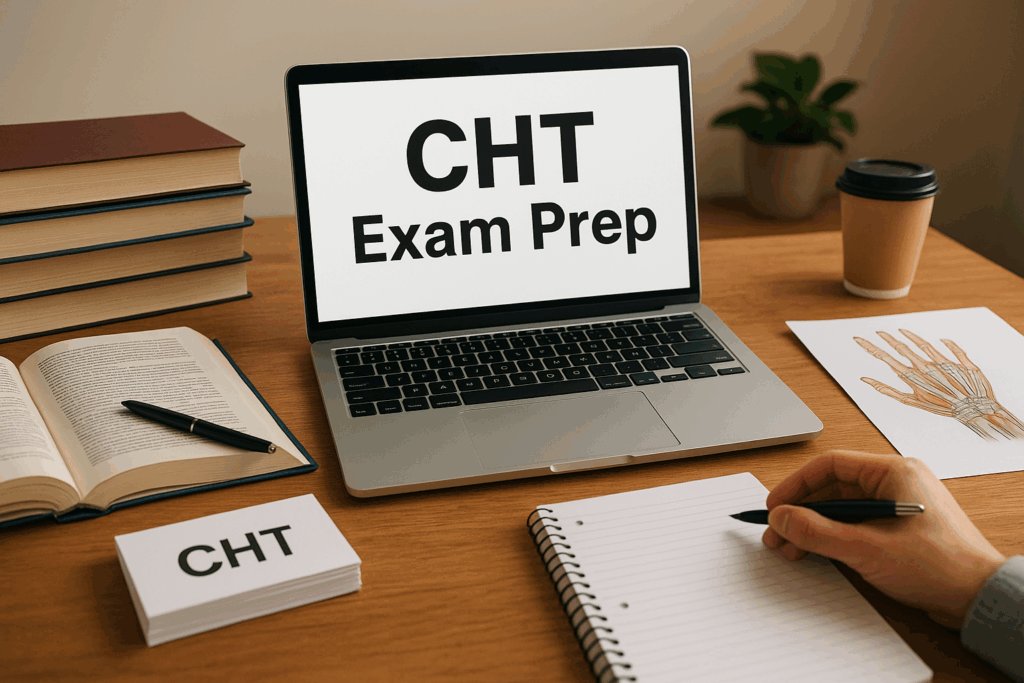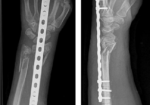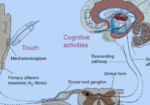Guide ultime de préparation à l'examen CHT : stratégies éprouvées pour réussir en tant que thérapeute de la main certifié
Classé sous Non classé
Introduction à l'examen CHT
Qu'est-ce que la certification CHT ?
Le titre de thérapeute certifié de la main (CHT) est une certification professionnelle prestigieuse et avancée destinée aux ergothérapeutes et aux physiothérapeutes. Il atteste de connaissances spécialisées en rééducation des membres supérieurs, notamment de la main, du poignet, du coude et de l'épaule. Ce titre est administré conjointement par la Commission de certification des thérapeutes de la main (HTCC) et est reconnu mondialement dans le milieu clinique des thérapeutes de la main.
Qui est admissible à passer l’examen CHT ?
Pour être admissible à l'examen CHT, un candidat doit :
- Être un ergothérapeute ou un physiothérapeute agréé.
- Avoir au moins 3 ans d’expérience clinique.
- Compléter un minimum de 4 000 heures de pratique directe en thérapie manuelle.
Ces conditions préalables strictes garantissent que seuls des professionnels dévoués et expérimentés tentent cet examen difficile.
Pourquoi devenir un thérapeute de la main certifié ?
Devenir CHT présente de nombreux avantages :
- Reconnaissance et crédibilité professionnelles
- Potentiel salarial plus élevé
- Des opportunités d'emploi élargies
- Prise de décision clinique améliorée
- Augmentation de la confiance des patients et des possibilités d'orientation
Cette certification peut être un tournant dans votre carrière en réadaptation.

Comprendre la structure de l'examen
Format et durée
L'examen CHT comprend 200 questions à choix multiples. Vous devrez 4 heures pour passer le test. L'examen est administré dans les centres de test Prometric ou à distance, selon votre localisation et vos disponibilités.
Types de questions et domaines couverts
L'examen couvre quatre domaines de contenu principaux :
- Domaines de la thérapie de la main
- Diagnostics et conditions
- Procédures médicales et chirurgicales.
- Techniques et outils de traitement
Attendez-vous à des scénarios basés sur des cas, à des questions basées sur des diagrammes et à des défis de prise de décision clinique qui testent l'application concrète des connaissances.
Système de notation expliqué
Les scores sont échelonnés entre 200 et 800. Le score de réussite exact varie légèrement selon l'année et la forme du test. Vous recevrez vos résultats dans les 6 à 8 semaines suivant l'examen.
Établir une base solide
Comment définir des objectifs SMART pour étudier
Les objectifs SMART (Spécifiques, Mesurables, Atteignables, Réels et Temporels) sont essentiels à un apprentissage structuré. Par exemple :
- « Je compléterai deux chapitres de mon manuel de révision chaque semaine. »
- « Je terminerai 100 questions d'entraînement chaque week-end. »
Créer un plan d'études personnalisé
Décomposez votre programme d'étude en objectifs hebdomadaires et mensuels, en fonction du temps dont vous disposez avant l'examen. Incluez :
- Couverture du matériel d'étude de base
- Journées d'examen pratique
- Semaines de repos et de révision
Calendrier d'étude recommandé
| Calendrier des études | Idéal pour |
| 12 mois | Travailler à temps plein avec des obligations familiales ou autres |
| 6 mois | Disponibilité modérée, charge de travail équilibrée |
| 3 mois | Préparation intense et ciblée à temps plein |
Meilleures ressources d'étude pour la préparation à l'examen CHT
Meilleurs livres et manuels
- Rééducation de la main et du membre supérieur par Skirven
- Intervention orthétique pour la main et les membres supérieurs par Jacobs & Austin
- Principes fondamentaux de la thérapie de la main par Coppard & Lohman
Cours en ligne et webinaires
- Cours préparatoires approuvés par l'AOTA, tels que Préparation CHT par Hand Therapy Academy
- Les chaînes YouTube des professionnels de la réadaptation
- Webinaires ASHT et ressources de formation continue
Techniques d'apprentissage actif
Apprentissage par cas
Appliquez la théorie à la pratique en examinant des études de cas cliniques. Réfléchissez de manière critique : quel est le diagnostic ? Quelles interventions choisiriez-vous ?
Enseigner des concepts aux autres
Enseigner vous oblige à comprendre les concepts en profondeur. Organisez des mini-séances de restitution avec vos pairs ou collègues.
Questions pratiques et examens blancs
Passez des tests blancs complets et chronométrés. Utilisez vos résultats pour ajuster votre concentration.
Gérer son temps et éviter l'épuisement professionnel
Conseils pour la planification des études hebdomadaires
- Bloquez 30 à 60 minutes par jour.
- Réservez du temps le week-end pour des plongées en profondeur.
- Inclure des pauses et des journées de « rattrapage ».
Éviter de se sentir dépassé
Identifiez rapidement les signes d'épuisement professionnel : fatigue, frustration, baisse de rétention. Adaptez votre rythme et adoptez des stratégies de gestion du stress.
Équilibre entre repos, nutrition et exercice
- Dormez 7 à 8 heures.
- Mangez des repas équilibrés contenant des nutriments qui stimulent le cerveau.
- Incluez des mouvements ou des exercices légers dans votre routine.
Stratégies de mémorisation des concepts clés
Mnémoniques et acronymes
Exemples :
- « Certains amoureux essaient des positions qu'ils ne peuvent pas gérer » – pour l’ordre des os du carpe.
- "DÉFORMER" – étapes de la cicatrisation des plaies.
Morceaux et répétition espacée
Divisez les sujets en sections faciles à comprendre et revenez-y fréquemment. Utilisez des flashcards pour une répétition espacée.
Diagrammes visuels et cartes mentales
Dessinez les trajets nerveux, les zones tendineuses et les modèles d'orthèses. Cette technique est particulièrement utile aux apprenants visuels.
Rejoindre un groupe d'étude ou un forum
Avantages de l'apprentissage par les pairs
- Responsabilité
- Partage d'idées
- Soutien émotionnel
Meilleures communautés d'étude CHT en ligne
- r/occupationaltherapy sur Reddit
- Groupes Facebook comme « Groupe d'étude pour l'examen CHT »
- Communautés Discord OT/PT
Trouver un partenaire d'étude
Associez-vous à quelqu'un qui prépare également l'examen. Vous pourrez vous interroger mutuellement et partager vos connaissances.
Stratégie de test pratique
Comment analyser vos erreurs
Après chaque test pratique :
- Catégoriser les erreurs par sujet.
- Révisez et réapprenez ce concept.
- Refaire le test après quelques semaines.
- Utilisez les catégories de post-test de Préparation au CHT des examens de la Hand Therapy Academy
Gestion du temps pendant les examens
- Ne consacrez pas plus de 1,5 minute à chaque question.
- Signalez les plus difficiles et revenez-y avec le temps restant.
Simulation de conditions d'examen réelles
Asseyez-vous à un bureau, sans distractions. Utilisez un minuteur. Ne prenez des pauses qu'à des heures précises, en imitant le comportement réel pendant l'examen. Utilisez le Test pratique CHT simulateur qui contient 200 questions issues de tests réels (trois versions du test sont disponibles) et fournit des commentaires détaillés avec justification et références pour toutes les réponses.
La veille de l'examen CHT
Quoi apporter
Préparez votre sac à l'avance et assurez-vous qu'il comprend :
- Pièce d'identité avec photo émise par le gouvernement
- Courriel de confirmation Prometric ou lettre d'admission au test
- Bouteille d'eau jetable (si autorisée)
Confirmez le lieu du test et le temps qu’il vous faudra pour vous y rendre.
Comment calmer l'anxiété pré-examen
- Méditez pendant 5 à 10 minutes en utilisant des applications comme Headspace ou Calm.
- Limitez votre consommation de caféine et visez un sommeil réparateur.
- Évitez le bachotage ; une révision légère est meilleure pour la rétention.
Stratégie d'examen final
Se concentrer sur:
- Flashcards et notes rapides
- Résumés à haut rendement
- Sujets que vous oubliez systématiquement lors des tests pratiques
N’introduisez pas de nouveau matériel à la dernière minute : cela peut augmenter le stress sans améliorer les performances.
Conseils pour réussir le jour du test
Arrivée anticipée et enregistrement
Prévoyez d'arriver au moins 30 à 45 minutes plus tôtLes centres de test ont des protocoles stricts :
- Les téléphones et les montres connectées ne sont pas autorisés
- Des casiers sont généralement fournis
- Vous pouvez être soumis à un contrôle de sécurité
Gérer le stress des examens en temps réel
Si vous commencez à vous sentir anxieux pendant le test :
- Prenez 3 respirations profondes
- Étirez discrètement vos bras et votre cou
- Fermez les yeux pendant 30 à 60 secondes pour éviter la fatigue oculaire
Rester concentré et alerte
- Utilisez le minuteur à l'écran pour vous rythmer
- Prenez les pauses autorisées à bon escient
- Ne vous attardez pas sur les questions difficiles, notez-les et passez à autre chose.
Que faire après l'examen
Comprendre les scores préliminaires
Dans certains centres, vous pourrez recevoir un réussite/échec préliminaire notification. Le rapport de score officiel arrivera par e-mail ou sur votre compte HTCC dans quelques semaines.
Étapes si vous réussissez
- Célébrez votre réussite !
- Mettez à jour vos informations d'identification
- Informez votre employeur et votre réseau
- Envisagez de conseiller d’autres personnes qui se préparent à l’examen
Que faire si vous ne réussissez pas
- Attendez une répartition de votre score
- Réfléchir aux domaines à améliorer
- Faites une courte pause avant de reprendre la préparation
- Vous pouvez repasser l'examen en 6 mois
Histoires de réussite de véritables CHT
Ce qui a fonctionné pour eux
- « J’ai commencé 6 mois à l’avance et j’ai étudié 5 jours par semaine. »
- « La pratique du test réel sur le site Web de l’HTA a changé la donne. »
- « Les flashcards quotidiennes m'ont aidé à maîtriser l'innervation nerveuse. »
Routines d'étude partagées
- Critiques matinales
- Examens pratiques hebdomadaires
- Résumés du dimanche des apprentissages hebdomadaires
Leçons apprises
- « Ne négligez pas les orthèses, même si vous pensez les connaître. »
- « Investissez dans des ressources de qualité, cela vous fera gagner du temps. »
- « Intégrez les jours de repos à votre programme. »
Principales erreurs à éviter lors de la préparation à l'examen CHT
Procrastination
Retarder votre programme d'étude augmente l'anxiété et diminue la rétention. Commencez tôt et restez régulier.
Ignorer les points faibles
Se concentrer uniquement sur ses sujets favoris crée des lacunes. Identifiez vos faiblesses dès le début grâce à des tests pratiques.
Ne pas passer suffisamment d'examens pratiques
Les examens blancs développent l'endurance et permettent de simuler les conditions d'examen. Essayez de terminer au moins 3 tests blancs complets.
FAQ sur la préparation à l'examen CHT
1. À quel point l’examen CHT est-il difficile ?
L'examen CHT est exigeant en raison de l'étendue du contenu et du raisonnement clinique requis. Mais grâce à une préparation rigoureuse et ciblée, de nombreux thérapeutes réussissent dès leur première tentative.
2. Quel est le taux de réussite ?
Le taux de réussite oscille généralement autour de 60–70%, selon l'année. La préparation est cruciale.
3. Combien de temps dois-je consacrer à mes études ?
La plupart des candidats étudient entre 150 à 300 heures Sur une période de 3 à 12 mois. Votre échéancier dépend de votre expérience et du temps d'étude disponible.
4. Existe-t-il des cours préparatoires qui garantissent des résultats ?
Aucun cours ne peut garantir la réussite, mais des cours réputés comme Cours de préparation au CHT La Hand Therapy Academy offre une structure et un soutien précieux.
5. Puis-je travailler à temps plein et réussir l’examen CHT ?
Oui ! De nombreux candidats ont réussi à concilier travail à temps plein et études en élaborant des plans structurés et en utilisant les week-ends ou les matins.
6. À quelle fréquence puis-je repasser l’examen ?
Vous pouvez repasser l'examen CHT tous les 6 mois, jusqu'à trois fois sur une période de 3 ans à compter de l'éligibilité initiale.
Conclusion : vous pouvez réussir l'examen CHT en toute confiance
Se préparer à l'examen CHT est un parcours qui permet non seulement d'acquérir des connaissances, mais aussi de développer sa confiance clinique. En élaborant un plan intelligent, en utilisant les meilleures ressources et en accordant la priorité à votre santé mentale et physique, vous pouvez absolument réussir l'examen CHT.
N’oubliez pas que chaque thérapeute de la main certifié a commencé exactement là où vous êtes maintenant : avec des questions, des doutes et de la détermination.
Restez concentré. Soyez constant. Et surtout, croyez en votre capacité à réussir.
Plus à lire
7 conseils pour vos patients souffrant d'arthrose !
7 conseils pour vos patients arthrosiques ! Gérer l'arthrose de la main Nos mains constituent l'une des structures les plus complexes du corps humain. Ils sont composés d’un réseau de tendons, de ligaments et de nerfs qui permettent d’effectuer des tâches quotidiennes comme déverrouiller une porte, éplucher un œuf ou encore envoyer un email…
En savoir plusRésultats des plaques de pontage dorsales
Résultats des plaques de pontage dorsales Fares, AB, Childs, BR, Polmear, MM, Clark, DM, Nesti, LJ et Dunn, JC (2021). Plaque de pont dorsal pour les fractures du radius distal : une revue systématique. Le Journal de Chirurgie de la Main. https://doi-org.methodistlibrary.idm.oclc.org/10.1016/j.jhsa.2020.11.026 Les fractures maigres du radius distal (DRF) sont une blessure courante que nous constatons dans…
En savoir plusLésion du nerf périphérique : évaluation du retour sensoriel par un thérapeute de la main.
Retour sensoriel après une blessure à la main, en particulier une lésion du nerf périphérique. Après une lésion du nerf périphérique, il existe souvent des altérations de la fonction sensorielle et/ou de la fonction motrice. Le taux de guérison varie en fonction du degré de blessure, de l'état de santé général du patient et de son âge. Après une blessure, c’est important…
En savoir plusTrigger Finger… Rapide et sale !
Ceci est pour vous… Thérapeutes de la main ! La ténosynovite sténosante, également connue sous le nom de doigt à ressaut, est une affection courante affectant les enfants et les adultes de tous âges. Faits en bref Le doigt à ressaut se produit généralement au niveau de la poulie A1. Il se produit avec une inflammation des tendons et des gaines du fds et du fdp. Le doigt peut se verrouiller à la fois en flexion et…
En savoir plusInscrivez-vous pour recevoir des mises à jour directement dans votre boîte de réception !
Inscrivez-vous avec nous et nous vous enverrons régulièrement des articles de blog sur tout ce qui concerne la thérapie des mains, des notifications chaque fois que nous mettons en ligne de nouvelles vidéos et tutoriels, ainsi que des documents, des protocoles et d'autres informations utiles.






